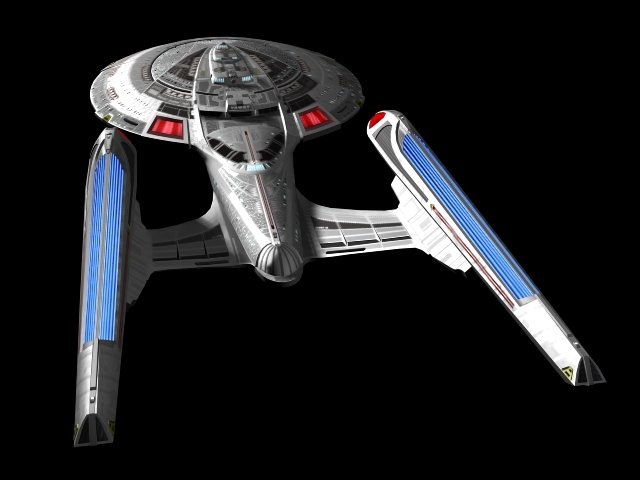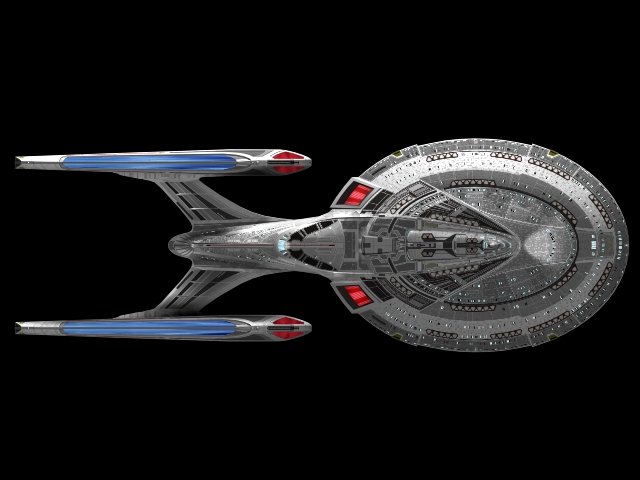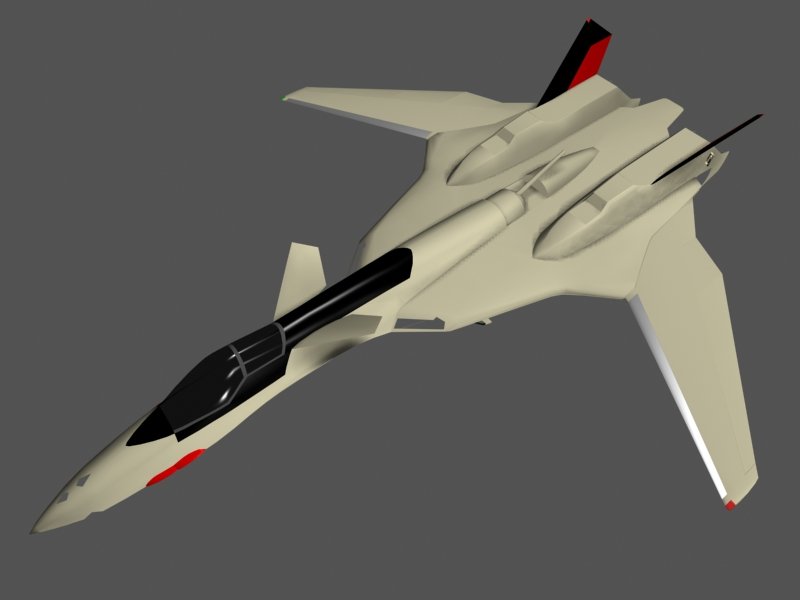-
Posts
10088 -
Joined
-
Last visited
Content Type
Profiles
Forums
Events
Gallery
Posts posted by Chronocidal
-
-
Mainly, most C models upgraded to a new engine... can't remember which.. but the nozzle is visibly different. They also enlarged the intake ducting for the newer engine, and enlarged the base of the tail, making it wider to hold more stuff, and longer, and added a small fin-like antenna to the leading edge of it.
Edit: k, this link pretty much sums it all up: http://www.f-16.net/reference/versions/f16_cd50.html
-
Jawjaw, I heartily agree.. the canopy is really the only feature I dislike on the YF-21... But then, I don't think the VF-22 is any better. I still don't understand that idiotic canopy frame. It would make much more sense to replace the whole thing with a single frameless bubble, or at least something streamlined.. that nasty bulging dome on top just looks ugly, and kills the sleekness of the design... not to mention the aerodynamics of it.

-
I still love that design.. I'm holding my breath that they'll pull a "Cobra" maneuver (in a different way) and revamp the F-23 to be a carrier based fighter... they could do it. It's not any bigger than a tomcat, I'm guessing... it's shorter too.. shoot, the tomcat's old, as much as I love it, what better to replace it than the F-23? They'd have to adapt it to work as an interceptor, but it could probably be done...
-
Well, remember.. they had to replace the dish after ROTJ

-
Heheh.. I wish I could be paid for this. This is actually a model that I made to put in some games I have. It kind of went a little beyond that, but it still works as an in-game model, although it makes most games run like a slug (it's 13,000 polygons). I don't have any actual renders of it up, but there are a few in-game shots of it I can link to. I'll just have to zip up the big renders and attach em.

There are a few screenshots of it in Bridge Commander as well, at these links:
I've got more shots as well, I made a full 5 view plan set. I just couldn't fit the rear and bottom views in the zip.
-
-
-
As for the best Star Wars game..... X-Wing Alliance is the best SW game to date.
True, true...
But damn, wouldn't it be nice to have the Tie Fighter storyline in the XWA engine?
Oh, BTW, does anybody knows why they changed the design of the Missile Boat so much? (Defender of the Empire had a kinda streamlined, eaglebeak looking one, everything else had a WAY blockier one. And no, it's not because XWA meshes were sucky).
Actually, I don't think there was really any reason why they changed the Missile boat. But, yes, the models in XWA are absolutely craptactular. The engine is capable of much more. If you miss that old missile boat though, go to www.xwaupgrade.com They're replacing all the stock models with beautiful works of art.. and the missile boat is back to its old design.
-
Personally, I wish they had made this kit a little bigger... I was hoping you could do things like pasting film cells in the windows.
 I have one of the old Ertl Ent-As, and it just doesn't compare to this thing's details. Sheesh, all that engraving, and still none of the panels had any reason to their arrangement.
I have one of the old Ertl Ent-As, and it just doesn't compare to this thing's details. Sheesh, all that engraving, and still none of the panels had any reason to their arrangement. I did notice some things about this kit though, and being absolutely broke after buying the thing, went the ghetto route to fix them. The lights in the windows are way too bright for one... they just look blinding. That's really easy to fix.. I just put a layer of masking tape over the clear inner parts before snapping on the outer hull panels. It dimmed the lights noticeably, and also helped to diffuse the light on the windows closest to the bulbs. I did nearly the same for the deflector. I put two layers of carefully cut wax paper, and a layer of blue cellophane between the lens and the clear light diffuser. I also put some of that blue cellophane in front of the bulbs in the nacelles to dim them a bit.. they were a bit too bright for my taste as well... I kind of wish they could have put the lights near the front, actually, instead of at the back.. looks kind of backwards somehow.

I really do wish that the parts had fit a little better, mainly the nacelles and pylons. Frankly, though I didn't want to risk gluing this thing. I think they used mixes of duck-egg blue and air-defense grey to make the panels, but I didn't want to try painting the seams myself, and possibly ruining what was already so nicely done. But the seams aren't too bad.. I can live with them. Maybe someday I'll get up the nerve, and glue it together.. besides, I wanted to be able to take this thing apart and rebuild it better later.. I may yet do it.
The one thing that has really continued to bug me is the way the panels cover the stand mount.. They gave two kinds of one panel, allowing you the option of mounting the model, or possibly hanging it.. The problem is swapping the panels if you want to plug the hole for separate display. Once you put the stand in, and snap those panels in, you're better off never removing the model from the stand again. Those panels don't like to come out, and you can scratch the paint horribly trying to. After my first couple of tries, I just don't use the front panel while it's mounted on the stand anymore. Just too much of a pain to remove.
I kind of was looking forward to the -E kit, but after spending the better part of two years making a CG model of that ship, nothing is going to stand up to the detail I would like to see.

-
Well, that's the problem. I'm not sure you're missing anything... but going from the art on the Mac+ dvd cover, that big close-up of the -19 winding up to punch, you've got the head mounted in the wrong place. It looks like it rotates around and actually pops out of the fuselage ahead of where you have it... I'm not sure of how things work entirely. But I did notice that even on the Yamato -19, the hip joints end up nearly in the center of the forward canards, meaning that the legs do move forward, shortening the waist. Also, you've left off that small black section ahead of the head. I think it actually drops away, and the head rotates into place there, bringing it much farther forward. I'd have to see the Yamato to see how it's done, but I think it would work... it would just take a lot of careful shaping to make sure the model fits together...
Btw, where did you get that YF-19 schematic? I went looking everywhere, but couldn't find a front view. If you could post it for me, I'd be ever so grateful

-
MK16, I think you may have left out a joint or two in the fuselage.... I'm not sure though. I think it's because of the simplified model. If you built the full head mechanism, it might work out better.. also, I think the shoulder rotation joint is in a little different place, that would put the arms further forward on the chest. I'll have to experiment with my model once it's done. There's got to be a way to do it... after all, I'm still hopeful for a 1/48th yamato YF-19.
-
(Ok, warning.. I'm gonna ramble. I tend to do this a lot. To get my point skim to the last paragraph.)
Mainly, that depends on which plane you want to model. Considering the accuracy of the 1/48 valks, there shouldn't be any problem making a VF-1, since they obviously work in real life, and look like they may fly.... although I'd hate to imagine the turbulence generated by the arms underneath.. not aerodynamic at all really. In fact, it's likely that most of these planes wouldn't really fly, without VERY advanced avionics systems to counteract the instability of the designs.
Anyway, getting the proportions correct can be a pain on some of them, especially the Mac+ ones.. They're very complex transformations, and although they can be done in real life, like the few transformable kits have proven, it's VERY hard to keep the proportions of one mode correct without fouling up the other modes. The fighter mode of the YF-19 is just beautiful in my opinion, but honestly, the Yamato 1/72 transforming version doesn't do the design justice. One of my friends commented that the fighter mode of the Yamato looked more like a bloated goose than an aircraft, and I could see what he meant. The intakes and rear fuselage are way too thick for the size of the plane. It looks very out of proportion in fighter mode to me... not at all like the Hasegawa fighter-mode model. Certain aspects of the aircraft had to be sacrificed to make a viable robot mode that would stand on its own. Now, on the other hand, I've seen people who converted the Hasegawa kit so that it DID transform.. I have no idea how. But I couldn't find pics of the battroid or gerwalk modes, so I can't tell you how they turned out. I could only tell because of the gaps between parts, and the places where hinges had been placed.
The main problem here is that these aircraft literally are not possible in our world. I'm guessing you've probably seen the way the wings of the YF-21 worked. They literally could change shape, almost like a bird's wing, which can change individual feathers to change its shape. If that wing can do that, I would assume that they could apply that technology to other parts of the aircraft, changing the shapes of various parts to fit together like an organic being, instead of a rigid metal airframe. This can't be done in real life obviously, but you can do it on the computer. In order to get the best proportions for all the modes, you may have to scale certain parts during the transformation.. in the case of the YF-19 you may need to shrink the nose and enlarge the head for it to appear correctly in battroid mode, after being in fighter mode. It's a balance.
To start off, modeling the separate parts is probably a good idea. The VF-1 is pretty blocky overall, and fits together simply, so it shouldn't be hard to get the parts to transform correctly. Starting in fighter mode is probably best, since that's where the fitting of the joints is crucial.. you can make the fuselage one piece, then break it later so it folds. The YF-19 is an entirely different story. I don't fully understand it's transformation to begin with, since I've never seen any examples. But the shape is so flawlessly smooth, it's difficult to tell where the joints are. You can see the lines for the joints, yes, but there's no physical break in the curvature of the surface. This thing demands you build it in one piece, then break it up later.. and that can be a problem, since the parts later have to all break apart, and turn into a correctly proportioned battroid. From the other end, if you build the model first as a correctly proportioned battroid, you might be up a creek when you attempt to fit the parts together to make the fighter. Sheesh, even the Yamato has that problem, with the joints and fuselage not coming together all the way. It's a big tradeoff that depends on what you want to do. If you want an accurate battroid, the plane probably won't fit together. If you build a nice fighter, the battroid may have a tiny head and limbs that don't look beefy enough.

-
Hmm... someone needs to make a conversion for some existing flight sim, or combat sim of some sort. Combat Flight Sim 3 could possibly work for complex transformation animations, since the game uses loads of model animation that's assigned to different keystrokes, but no missiles, and obviously no spaceflight involved would limit it. It's all flight... you'd need a cross between a flight sim and something like Mechwarrior, and an engine that could switch between control setups.
Btw, I don't know for sure if that model would work in any game I know of.. I don't think that's the full polygon wireframe in that picture. All the games I've ever modded required that the models be made entirely of triangle faces, otherwise you get nasty distortions if the faces aren't perfectly flat. Some games will support quad-faces, but not like that. Those look more like control polygons, made up of multiple triangles, not individual faces. A lot of times, the contours of a model depend on which way you divide a quadrilateral space between two triangles... you can divide any quad two ways, contouring depends on picking the right direction for the shape you're modeling.. it's a royal pain, and for me, usually involves drawing individual faces, one at a time, until the shape looks right. I tried nurbs modeling, but I just couldn't get the control over the shape that I wanted. That whole YF-19 was made by me drawing the main contours with polylines, then filling in the space with individual triangles. If I ever learn to model with surfaces and such, I'll probably be very happy... I just haven't gotten to it yet.

-
Personally, I'd probably kill for a YF-19 done like the 1/48 valks... The 1/72 transforming one is a great achievement to actually make, but I'd like to see one in accurate proportions, that looks like the Hasegawa kit while in fighter mode. Heck, I'd like to see that for all the Macross+ stuff. But it won't happen, at least not at affordable prices. Think how much a YF-19 or YF-21 would cost in 1/48 scale... they're both huge planes.
-
Heheh.. the only problem with scanning directions is getting them lined up right.. my scanner tends to rotate things a degree or two. I'm waiting on my Hasegawa VF-1J and YF-19 to get here from ebay before I start modeling them properly (I'm hoping to do a whole series of planes for flight sims eventually). When I do, I'm probably going to have to start almost from scratch on the -19... the Hasegawa model is very accurate in appearance, but it doesn't agree with any of the blueprints I've found. There're some big differences in the shape of the legs, among other things. What would be REALLY nice is a set of cross-sections...
One thing though... I'd like to make this YF-19's wings swing like is shown in the technical drawings, for high speed flight.. but how are those wings supposed to fold back? Do they actually change shape like the YF-21's? cause otherwise, the wings are going to slice right through the engines.

-
Hi, I'm REALLY new here, but you guys have some amazing stuff... I really love those VF-1's...
Mainly, I have a question about the YF-19 from Macross Plus... Does anyone know where I can get some decent blueprints of it? I've got a very nice scan of the top, with measurements, etc. on it, but I really need schematics of the front, and bottom views, and the rear if possible. I'm working on a polygon model of it that I plan on putting in various flight sims, mainly MS Flight Sim 2002, and I've got most of the top half of the model done, but the bottom is pretty much non-existent. I've been going mainly off of pictures of the Hasegawa model, but I don't have any decent shots of the bottom or rear of the plane. If anyone knows where I can get some shots of it, I'd be oh so grateful.. I've ordered the kit online, but I'm extremely bored, and don't want to wait for it to get here.

Btw, for those of you with flight sim interests, there seems to be a severe shortage of Macross aircraft for any flight sim... the most I've found is a simply made VF-1 for Microsoft Flight sim. There are tons of possibilities in the MSFS 2002 engine though... I wouldn't rule out transforming either, since you can link commands in the program to animations like the canopy opening, arrestor hook dropping, etc Walking in battroid mode might not work too well, but there may be a way to do it. If any of you have the time or inclination, I'd love to see more Macross mods for games.
But anyway, enough begging, here's what I've gotten so far on this model....





Valk size comparison...
in Fan Works
Posted
Whoops... yep, you're right that is just about the later differences.. oh well.. that explains why you see so many C model tails with the old engine.. I think the Thunderbirds still use the old engine, or they did the last time I saw them fly (which was a while ago), as does the airbase near my home, so that would explain that. David, I'm guessing you work with aircraft in some way? Either that, or you've got an incredible memory for aircraft trivia.
David, I'm guessing you work with aircraft in some way? Either that, or you've got an incredible memory for aircraft trivia. 